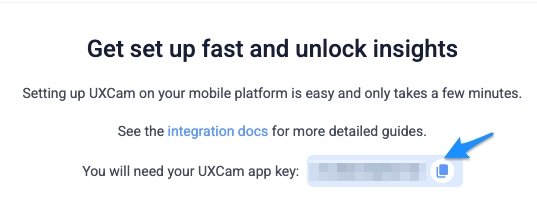iOS SDK Integration Guide
How to Get Started with UXCam for iOS
Note
Need an account? **Start free ** – most teams complete this setup in under 15 minutes..
Integration Journey at a Glance
Step 1: Customize SDK Configuration
Capture your first live session.
Tip
★ Optional but highly recommended. Ship steps 1-3 to start getting session replays and heatmaps, then add steps 4-5 for deeper analytics.
Key Benefits After Setup
- Session Replay + Heatmaps – Watch every user experience moment in full context.
- Advanced Product Analytics – funnels, retention, feature adoption.
- Insight Alerts – journey summaries, rage-tap & anomaly detection.
- Engineering Analytics – Connect client-side performance to real sessions. Monitor crashes, ANRs, and handled exceptions with session replay and developer logs for faster debugging.
Tips Before You Begin
- Create separate keys for debug & production to keep data clean.
- Use feature flags to toggle UXCam in staging builds.
- Check Logcat for “Verification successful” and “Session/Video uploaded” messages to confirm the integration is working correctly.
Note for SwiftUI developers:If you're working with SwiftUI, you may add the dedicated SwiftUI SDK instead of the regular iOS one, you can check the initial setup here.
Step 1: Get your App Key
1.1: Find your app key
If you don't already have it, find it in App Settings -> App Key on your UXCam Dashboard.

Important
Create separate keys for debug/production. Keep your data clean, no need to mix test actions with real user insights!
1.2: Keep it out of source control:
Put the key in an ignored .xcconfig file or pass it in as an environment variable from your CI, then reference it via a build-setting placeholder (e.g. $(UXCAM_APP_KEY)) so the value is injected at compile-time and never hard-coded in source.
Quick Start: Only a Couple of Lines of Code
Let's get you started with the basics. With just a few lines of code, you'll be on your way to capturing user sessions in your test app.
Adding the Dependencies
Cocoapods
- Add UXCam to your
Podfile:
pod 'UXCam'
- Run
pod installin the project directory to download dependency.
Swift Package Manager
- If you prefer Swift Package Manager, you can add UXCam using the following URL:
https://github.com/uxcam/uxcam-ios-sdk
Specify the exact version to ensure compatibility.
Initializing UXCam
- Imports:
import UXCam- Configuration
Add the following initialisation to application:didFinishLaunchingWithOptions: in your AppDelegate:
let configuration = UXCamConfiguration(appKey: "YOUR_APP_KEY")Replace "YourAppKey" with the app key available on your UXCam dashboard.
- Then, start the SDK with your configuration object
import UXCam
func application(_ application: UIApplication,
didFinishLaunchingWithOptions launchOptions: [UIApplication.LaunchOptionsKey: Any]?) -> Bool {
let config = UXCamConfiguration(appKey: "YOUR_APP_KEY")
UXCam.optIntoSchematicRecordings()
#if DEBUG
// 🔍 Enable verbose integration logs in Debug builds only
config.enableIntegrationLogging = true
#endif
UXCam.start(with: config)
return true
}Available Configuration Options:
enableAutomaticScreenNameTagging
Used to disable automatic screen tagging if manual tagging of the screens will be done, default is true
enableAdvancedGestureRecognition
Control the gesture recognizers used by UXCam. Set TRUE to enable the full range of gesture recognizers (the default) or FALSE to limit it to basic gestures.
enableCrashHandling:
Crash handling is enabled by default, to let you capture all the sessions with crashes and see the corresponding crash logs.
Build & Test
Run the app on a simulator or device, navigate a few screens, then send it to the background. Your first session replay will appear on the UXCam dashboard within seconds.
As Simple As That!This will complete the integration process.
Your session will be shown on the dashboard within a few seconds after the app goes in the background.We recommend that after you've set this up and have reviewed some sessions from your tests, get to the customisation features UXCam offers, let's go to the next steps!
Video Tutorial:
Next Steps ➡️
You’ve successfully integrated UXCam and sent some sessions, great job! 🎉 But there's so much more you can do. Now, let’s go further into setting things up.
Take full advantage of heatmaps and screen analytics.
Review Automatic or Manual Tagging
Protect your users’ privacy by masking sensitive data.
Mask or Blur Screens, Views and Fields
Get the full picture with user-level analytics.
Assign Custom User IDs and Properties
Gain deeper insights into your users' interactions.
Send Events and Add Properties
Updated 6 months ago

